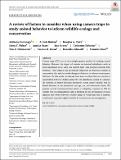Files in this item
A review of factors to consider when using camera traps to study animal behavior to inform wildlife ecology and conservation
Item metadata
| dc.contributor.author | Caravaggi, Anthony | |
| dc.contributor.author | Burton, A. Cole | |
| dc.contributor.author | Clark, Douglas A. | |
| dc.contributor.author | Fisher, Jason T. | |
| dc.contributor.author | Grass, Amelia | |
| dc.contributor.author | Green, Sian | |
| dc.contributor.author | Hobaiter, Catherine | |
| dc.contributor.author | Hofmeester, Tim R. | |
| dc.contributor.author | Kalan, Ammie K. | |
| dc.contributor.author | Rabaiotti, Daniella | |
| dc.contributor.author | Rivet, Danielle | |
| dc.date.accessioned | 2020-06-26T12:30:08Z | |
| dc.date.available | 2020-06-26T12:30:08Z | |
| dc.date.issued | 2020-06-19 | |
| dc.identifier | 268708838 | |
| dc.identifier | 49174f8d-9599-4751-804f-ed196a53f2c4 | |
| dc.identifier | 000543463200001 | |
| dc.identifier | 85096669927 | |
| dc.identifier.citation | Caravaggi , A , Burton , A C , Clark , D A , Fisher , J T , Grass , A , Green , S , Hobaiter , C , Hofmeester , T R , Kalan , A K , Rabaiotti , D & Rivet , D 2020 , ' A review of factors to consider when using camera traps to study animal behavior to inform wildlife ecology and conservation ' , Conservation Science and Practice , vol. Early View , e239 . https://doi.org/10.1111/csp2.239 | en |
| dc.identifier.issn | 2578-4854 | |
| dc.identifier.other | RIS: urn:272BE86EFA7220F8ADDE5E790020E950 | |
| dc.identifier.other | ORCID: /0000-0002-3893-0524/work/76386896 | |
| dc.identifier.uri | https://hdl.handle.net/10023/20162 | |
| dc.description.abstract | Camera traps (CTs) are an increasingly popular method of studying animal behavior. However, the impact of cameras on detected individuals—such as from mechanical noise, odor, and emitted light—has received relatively little attention. These impacts are particularly important in behavioral studies in conservation that seek to ascribe changes in behavior to relevant environmental factors. In this article, we discuss three sources of bias that are relevant to conservation behavior studies using CTs: (a) disturbance caused by cameras; (b) variation in animal‐detection parameters across camera models; and (c) biased detection across individuals and age, sex, and behavioral classes. We propose several recommendations aimed at mitigating responses to CTs by wildlife. Our recommendations offer a platform for the development of more rigorous and robust behavioral studies using CT technology and, if adopted, would result in greater applied benefits for conservation and management. | |
| dc.format.extent | 9 | |
| dc.format.extent | 1841901 | |
| dc.language.iso | eng | |
| dc.relation.ispartof | Conservation Science and Practice | en |
| dc.subject | Conservation behavior | en |
| dc.subject | Management | en |
| dc.subject | Observer bias | en |
| dc.subject | Remote sensing | en |
| dc.subject | Wildlife | en |
| dc.subject | BF Psychology | en |
| dc.subject | QH301 Biology | en |
| dc.subject | DAS | en |
| dc.subject.lcc | BF | en |
| dc.subject.lcc | QH301 | en |
| dc.title | A review of factors to consider when using camera traps to study animal behavior to inform wildlife ecology and conservation | en |
| dc.type | Journal article | en |
| dc.contributor.institution | University of St Andrews. School of Psychology and Neuroscience | en |
| dc.contributor.institution | University of St Andrews. Centre for Social Learning & Cognitive Evolution | en |
| dc.identifier.doi | 10.1111/csp2.239 | |
| dc.description.status | Peer reviewed | en |
This item appears in the following Collection(s)
Items in the St Andrews Research Repository are protected by copyright, with all rights reserved, unless otherwise indicated.

